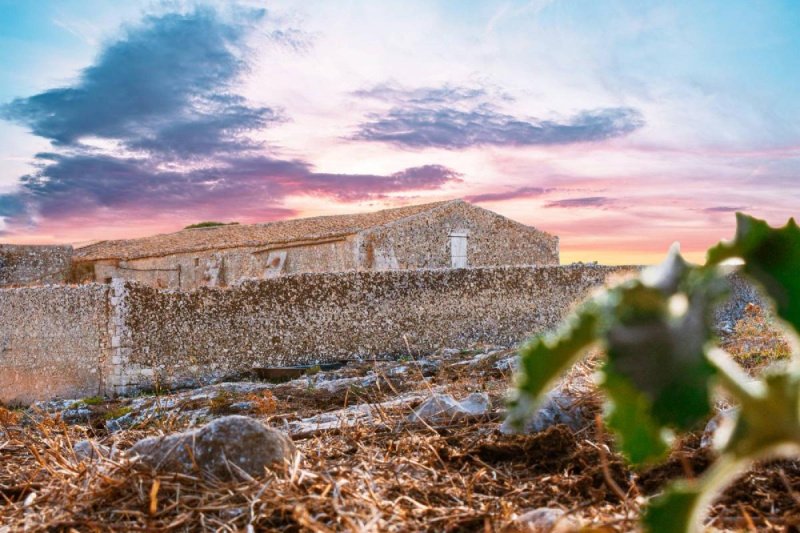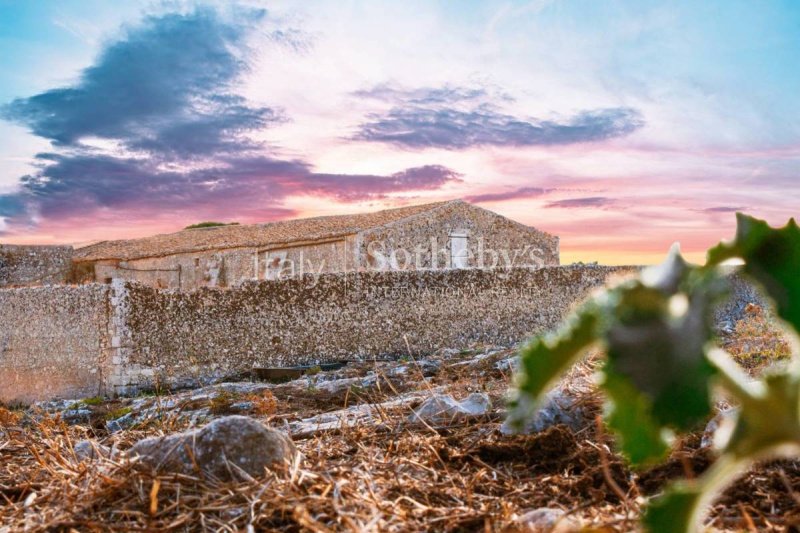Within the Cavagrande del Cassibile Nature Reserve lies this enchanting feudal hamlet in need of renovation, dating back to 1793 with a 3,000 square metre farmhouse, complete with a large courtyard and a charming chapel. The property covers some 162 hectares of land and boasts a fascinating history: in 1801 the feud was donated by King Ferdinand IV of Naples and III of Sicily (who in 1816 assumed the title Ferdinand I of the Two Sicilies) to Baron Gaetano Barresi. The current owners still keep the precious original document, handwritten and signed by the King. Of the 162 hectares in total, 90 are cultivable: currently, 40 hectares are dedicated to wheat cultivation, while the remainder, embellished by expanses of olive trees, are used for grazing. A recent feasibility study revealed the suitability of the land for planting an almond grove, offering further opportunities for agricultural development. The property has autonomous water resources thanks to boreholes with a constant average flow of about 15 litres per second and a large collection tank with a capacity of about 1 million litres of water. A panoramic view of the sea can be enjoyed from the highest part of the estate. In addition, the final portion of the property falls within the 'Cavagrande del Cassibile' Reserve and Pre-Reserve area, crossed by the river of the same name. This extraordinary place, known as the 'Grand Canyon of Sicily', is a major attraction for international tourism. Thanks also to its close location to the beautiful Noto, famous for its Baroque heritage, the feud lends itself perfectly to becoming a luxurious private residence or an exclusive eco-friendly boutique hotel.
Taal van waaruit de automatische vertaling is gegenereerd
All'interno della Riserva Naturale di Cavagrande del Cassibile si trova questo incantevole borgo feudale da ristrutturare, risalente al 1793 con masseria di 3.000 mq, che si completa di una grande corte interna e una suggestiva cappella. La proprietà si estende su circa 162 ettari di terreno e vanta una storia affascinante: nel 1801 il feudo fu donato dal Re Ferdinando IV di Napoli e III di Sicilia (che nel 1816 assunse il titolo di Ferdinando I delle Due Sicilie) al Barone Gaetano Barresi. Gli attuali proprietari custodiscono ancora il prezioso documento originale, scritto a mano e firmato dal Re. Dei 162 ettari complessivi, 90 sono coltivabili: attualmente, 40 ettari sono dedicati alla coltivazione di grano, mentre i restanti, impreziositi da distese di ulivi, sono destinati al pascolo. Un recente studio di fattibilità ha evidenziato l'idoneità del terreno per l'impianto di un mandorleto, offrendo ulteriori opportunità di sviluppo agricolo. La proprietà dispone di risorse idriche autonome grazie a pozzi trivellati con una portata media costante di circa 15 litri al secondo e una grande vasca di raccolta con una capacità di circa 1 milione di litri d'acqua. Dalla parte più alta del feudo si può godere di una vista panoramica sul mare. Inoltre, la porzione terminale della proprietà ricade nella zona di Riserva e Pre-riserva della "Cavagrande del Cassibile", attraversata dal fiume omonimo. Questo luogo straordinario, noto come il "Grand Canyon della Sicilia", è un'attrazione di grande valore per il turismo internazionale. Grazie anche alla vicinanza alla splendida Noto, celebre per il suo patrimonio barocco, il feudo si presta perfettamente a diventare una lussuosa residenza privata o un esclusivo boutique hotel eco-friendly.
Inmitten des Naturparks Cavagrande del Cassibile liegt dieser bezaubernde, renovierungsbedürftige Feudalweiler aus dem Jahr 1793 mit einem 3.000 Quadratmeter großen Bauernhaus mit großem Innenhof und einer charmanten Kapelle. Das Anwesen erstreckt sich über 162 Hektar Land und hat eine faszinierende Geschichte: 1801 wurde das Lehen von König Ferdinand IV. von Neapel und III. von Sizilien (der 1816 den Titel Ferdinand I. von den Beiden Sizilien annahm) dem Baron Gaetano Barresi geschenkt. Die heutigen Eigentümer bewahren noch immer das wertvolle Originaldokument auf, das vom König handgeschrieben und unterzeichnet wurde. Von den insgesamt 162 Hektar können 90 Hektar bewirtschaftet werden: 40 Hektar sind derzeit dem Weizenanbau gewidmet, während die restlichen Hektar, die von ausgedehnten Olivenhainen geschmückt werden, als Weideland genutzt werden. Eine kürzlich durchgeführte Machbarkeitsstudie hat ergeben, dass sich das Land für die Anpflanzung eines Mandelhains eignet, was weitere Möglichkeiten für die landwirtschaftliche Entwicklung bietet. Das Grundstück verfügt über autonome Wasservorkommen dank Bohrlöchern mit einem konstanten durchschnittlichen Durchfluss von etwa 15 Litern pro Sekunde und einem großen Sammeltank mit einem Fassungsvermögen von etwa 1 Million Litern Wasser. Vom höchsten Teil des Anwesens aus hat man einen Panoramablick auf das Meer. Der letzte Teil des Anwesens liegt im Naturschutzgebiet Cavagrande del Cassibile", das von dem gleichnamigen Fluss durchquert wird. Dieser außergewöhnliche Ort, der als Grand Canyon Siziliens" bekannt ist, ist eine große Attraktion für den internationalen Tourismus. Dank seiner Nähe zum schönen Noto, das für sein barockes Erbe berühmt ist, eignet sich das Lehen perfekt für eine luxuriöse Privatresidenz oder ein exklusives, umweltfreundliches Boutique-Hotel.
Dans la réserve naturelle de Cavagrande del Cassibile se trouve ce charmant hameau féodal à rénover, datant de 1793 et comprenant une ferme de 3 000 mètres carrés, avec une grande cour et une charmante chapelle. La propriété s'étend sur 162 hectares et possède une histoire fascinante : en 1801, le fief a été donné par le roi Ferdinand IV de Naples et III de Sicile (qui, en 1816, a pris le titre de Ferdinand I des Deux-Siciles) au baron Gaetano Barresi. Les propriétaires actuels conservent le précieux document original, écrit à la main et signé par le roi. Sur un total de 162 hectares, 90 sont cultivables : actuellement, 40 hectares sont consacrés à la culture du blé, tandis que le reste, agrémenté d'étendues d'oliviers, est utilisé pour le pâturage. Une récente étude de faisabilité a révélé que le terrain se prêtait à la plantation d'une amanderaie, ce qui offre d'autres possibilités de développement agricole. La propriété dispose de ressources hydriques autonomes grâce à des forages d'un débit moyen constant d'environ 15 litres par seconde et à un grand réservoir de collecte d'une capacité d'environ 1 million de litres d'eau. La partie la plus élevée de la propriété offre une vue panoramique sur la mer. En outre, la dernière partie de la propriété se trouve dans la zone de réserve et de pré-réserve de Cavagrande del Cassibile, traversée par la rivière du même nom. Ce lieu extraordinaire, connu comme le « Grand Canyon de la Sicile », est une attraction majeure pour le tourisme international. Grâce également à sa proximité avec la splendide ville de Noto, célèbre pour son patrimoine baroque, le fief se prête parfaitement à devenir une luxueuse résidence privée ou un hôtel-boutique exclusif et respectueux de l'environnement.


